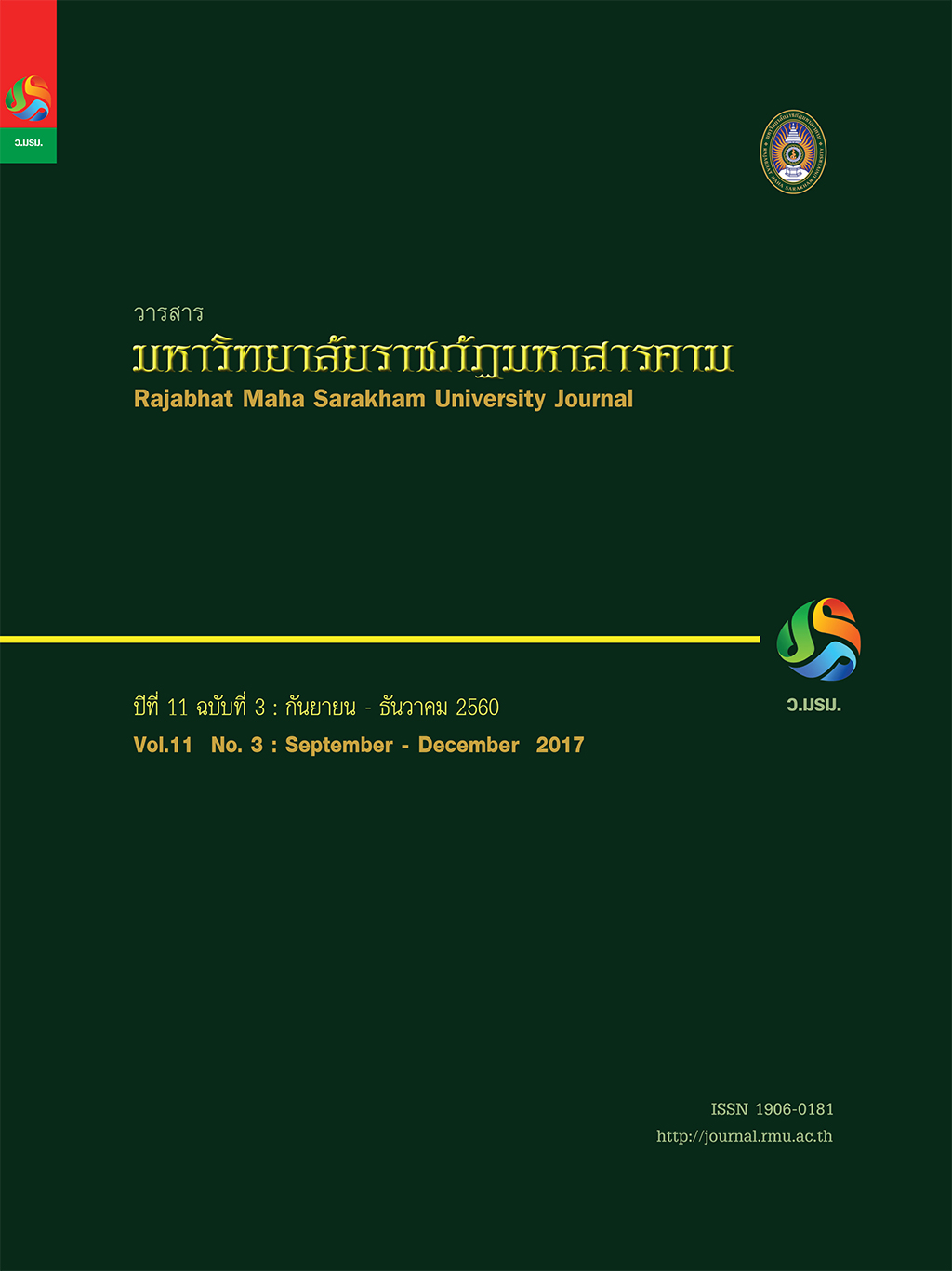Participation for Development of Life Skills of Students in Phanomsarakham Industrial and Community Education College, Chachoengsao Province
Main Article Content
Abstract
The purpose of this research were 1) to study the participation levels of developing life skills for the students
at Phanomsarakham Industrial and Community Education College, 2) to compare the participation levels of
developing life skills for the students at Phanomsarakham Industrial and Community Education College
according to the categorization of genders and fields of study. The sample groups of this research were 372
students studying at Phanomsarakham Industrial and Community Education College, Chachoengsao province
by used simple random sampling. The instrument in this research was questionnaires Participation for
Development of Life Skills of Students in Phanomsarakham Industrial and Community Education College,
Chachoengsao Province. Analysis of descriptive statistics and Multivariate Analysis of Variance (MANOVA)
were analysis by computer program.
The results were as follows:
1. The study of participation levels of developing life skills for the students of Phanomsarakham
industrial and communication education college, there were four skills at the level high and ranked from
maximum to minimum according to the mean average as follows: evaluation skill, implementation skill,
decision-making skill, and benefits skill respectively.
2. Comparing the participation levels of developing life skills for the students of Phanomsarakham
Industrial and Community Education College, Chachoengsao Province according to the categorization of
genders and fields of study, it was found that the people who different genders and fields of study. The research
found female were the participation levels of developing life skills over than male and Metal Technology fields
were the participation levels of developing life skills over than other fields of study
Article Details
1. All articles undergo a thorough with at least three reviewers evaluating their suitability within the respective field of study, during the double-blind review.
2. The views expressed by individual authors do not represent the official views of the Editorial Boards of RMUJ: The author of each articie is responsible for all its contents.
3. The Editorial Boards do not reserve the copyrights. but proper citations need to be made.
References
Need For Health Promotion Activities of the
Undergraduate Student at Silpakorn University,
Sanamchamdra Palace. Master of Science
Independent Study, Silpakorn University, Nakorn
Pathom.
[2] Ministry of Education. (2009). Classroom: The
Smaller is Better?.[Online].14 April2007, fromhttp://
www.moe.go.th/moe/th/news/detail.php?NewsID
=8393&Key=newsresearch
[3] Punya-apiwong, Kunsinee and Sungrugsa, Narin.
(2015). “Life Skills for self-Determining Based on
Sufficiency Economic Philosophy of Bachelor’s
Degree Student in Silpakorn University.” Veridian
E-Journal, Silpakorn University. 8(1) : 138-152.
[4] Tianroek, Chanatda; Traiwichitkhun, Duangkamoland
Siriparp,Thomrat. (2015). Development of
Measurment Model of life and Career Skills of
Upper Secondary School Students in 21st Century
ojed. 10 (4) : 224-237
[5]Suwannapak, Tussaporn. (2007). Organizing the
Participatory Learning Activities for Enchancing
Grade Two Student’ Life Skill. Master of
Education (Educational Research and Evaluation),
Kasetsart University, Bangkok.
[6]Moontatong, Napatchawin. (2012). Life Skills and
Education for Children and Youth Development.
Journal of Education Rajabhat Maha Sarakham
University Vol. 9 No. 1 (16) January - June 2012
[7]Sirimedho(Thitipasitthikron), PhramahaPrakasit.
(2013). Participation of People in Community
Development of Sufficiency Economy Village of
Ban Klong Mai Community, Sampran District,
Nakhonpathom Province. Master of Arts (Social
Development), Mahachulalongkornrajavittayalaya
University, Bangkok.
[8]Kattawongkorn, Ramanaphat.(2014). Study of life
skills development for student in prathom 6 of
Bangjak (Komolprasertuthit) school, Phasichareon
District, Bangkok. Master of Education
Administration Thesis; Srinakharinwirot
University,
[9] Office of the Vocational Education Commission.
(2016).Vocational Preparation Program, Version
3 ; Create Moral Discipline and Life Skills for
Vocational Students. [Online].3 October2016, From
http://www.vec.go.th/portals/0/tabid/103/Arti
cleId/5817/5817.aspx
[10] Office of Academic and Educational Standards,
Office of the Basic Education Commission,Ministry
of Education. The Development of Life Skills Brooke
Integrated Teaching ; 8 Group Learning, Core
Curriculum Basic Education 2008. Bangkok : The
Agricultural Co-operative Federation of Thailand
LTD.
[11]Pongjanta, Anursara. (2014). The Development of
Learning Achievement on General Chemistry by
UsingPeer Assisted Learning for Health Science
Students. Office of Health Sciences, Chiang Rai
Rajabhat University ; February.
[12]Cohen, J.M., &Uphoff, N.T. (1981). Rural
Development Participation: Concept and Measure
for Project Design Implementation and
Evaluation: RuralDevelopment Committee
Center for internationalStudies. New York:
Cornell University Press.
[13]WorldHealth Organization, D.o.M.H. (1994).
Life skill seducation for childre nandschools. Pt.
1, Introduction to life skills for psychosocial
competence. Pt.2, Guidelines to facilitate the
developmentand implementation of life skill’s
programmer. Geneva : World HealthOrganization.
Retrieved November 13, 2016from http://www.
who.int/iris/handle/106 65/163552


